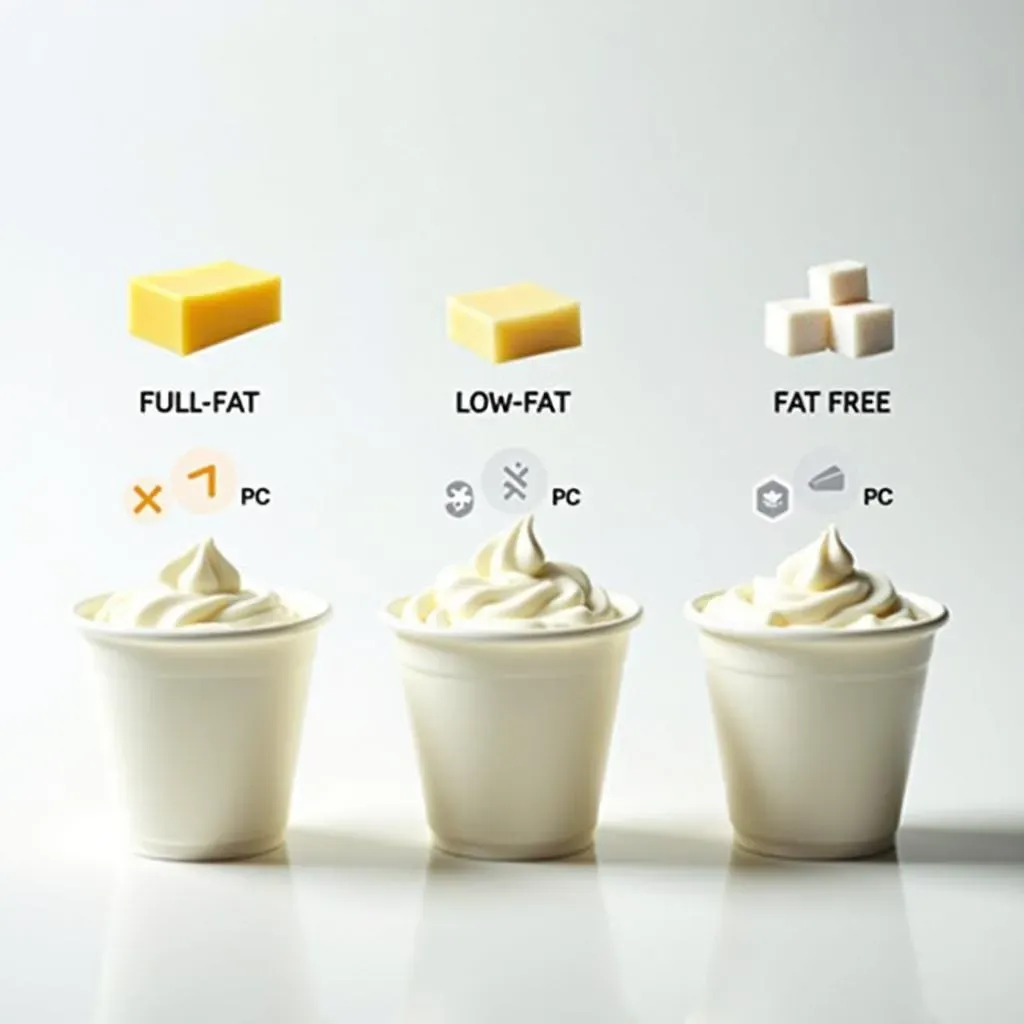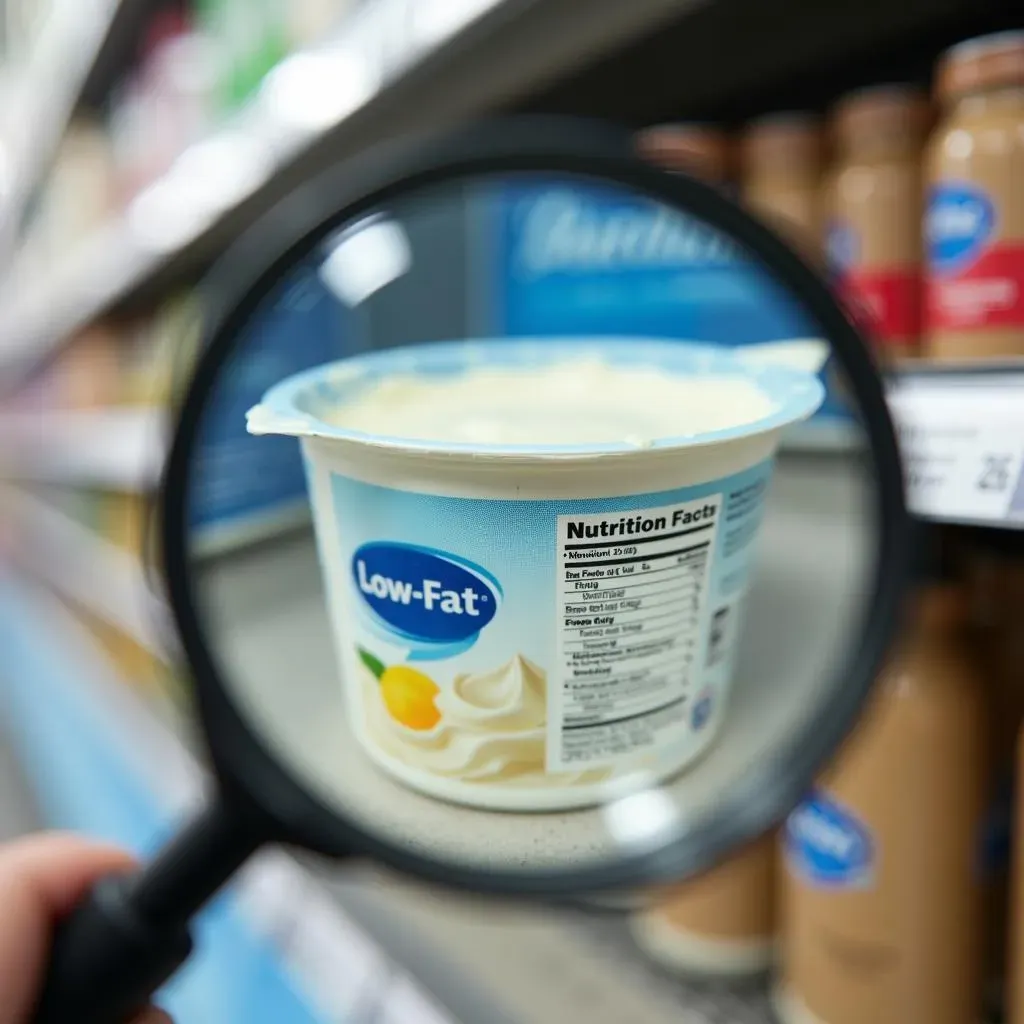Table of Contents
Navigating the dairy aisle can feel like cracking a secret code, especially when you're trying to make healthy choices. You grab a container of low-fat yogurt, thinking you're making a smart move. But have you ever stopped to wonder, "How much fat is *really* in low-fat yogurt?" It's a valid question! Marketing labels can be misleading, and understanding the nuances between "low-fat," "non-fat," and "full-fat" options is key to aligning your diet with your health goals.
Decoding "Low Fat": Understanding Fat Content in Yogurt

Decoding "Low Fat": Understanding Fat Content in Yogurt
So, you're staring down a yogurt container labeled "low fat," right? What does that *actually* mean? Legally, "low fat" means that the yogurt has to have 3 grams of fat or less per serving. Now, before you think, "Awesome, practically no fat!", it's worth digging a little deeper. Serving sizes can be sneaky, and what one brand considers a serving might be different from another. Always check the nutrition label to see the *actual* grams of fat per serving, and then compare that to the total size of the container. That way, you're comparing apples to apples, or, well, yogurts to yogurts.
Another point to consider is that different types of yogurt have different baselines. Greek yogurt, for instance, tends to be higher in protein and often lower in carbohydrates compared to traditional yogurt. But, depending on how it's made, it can also be higher in fat. So, a "low-fat" Greek yogurt might still have more fat than a "low-fat" traditional yogurt. It's all about reading those labels!
And hey, don't just focus on the fat! Look at the sugar content too. Sometimes, when manufacturers take out fat, they add in sugar to compensate for the flavor and texture. You might be saving on fat, but loading up on sugar instead, which isn't necessarily a win. It's about finding that balance that works for *you*.
LowFat Yogurt vs. FatFree & FullFat: A Nutritional Comparison

LowFat Yogurt vs. FatFree & FullFat: A Nutritional Comparison
Alright, let's line up the contenders: low-fat, fat-free, and full-fat yogurt. What are the real differences, beyond the obvious? Fat-free yogurt, as the name suggests, should have next to no fat – we're talking less than 0.5 grams per serving. Full-fat yogurt, on the other hand, can have a pretty wide range, depending on the brand and whether it's made with whole milk. We're talking anywhere from 5 grams to upwards of 15 grams of fat per serving. Now, remember that fat isn't the enemy! It plays a role in satiety and can help you absorb certain vitamins.
But the fat content is just the beginning. When you strip out the fat, something has to make up for the lost flavor and texture. Often, that "something" is sugar. So, a fat-free yogurt might have significantly more sugar than its full-fat counterpart. Similarly, some brands add thickeners or stabilizers to low-fat and fat-free yogurts to mimic the creamy texture of full-fat versions. These additives aren't necessarily *bad*, but it's worth being aware of them.
Yogurt Type | Fat Content (per serving) | Typical Sugar Content (per serving) | Potential Additives |
|---|---|---|---|
Full-Fat | 5-15+ grams | Varies, often lower than fat-free | Minimal |
Low-Fat | Up to 3 grams | Moderate | Thickeners, stabilizers |
Fat-Free | Less than 0.5 grams | Often high | Thickeners, stabilizers, artificial sweeteners |
Protein content can also vary. Greek yogurt, in general, packs more protein than traditional yogurt, regardless of the fat content. However, some brands might add protein isolates or concentrates to boost the protein levels in their low-fat or fat-free yogurts. Again, it's all about reading the label and understanding what you're *really* getting.
The Health Impact: Is LowFat Yogurt Always the Best Choice?

The Health Impact: Is LowFat Yogurt Always the Best Choice?
The Great Fat Debate: Saturated vs. Unsaturated
let's get real about fat. For years, we've been told that all fat is bad, especially saturated fat. But the science is evolving, and it's not quite that simple. Some studies suggest that saturated fat isn't the heart-health villain we once thought it was. What *is* clear is that unsaturated fats – like those found in olive oil, avocados, and nuts – are generally beneficial. So, when you're choosing a yogurt, don't just look at the total fat content. Consider the *type* of fat. Some full-fat yogurts might contain more saturated fat, while others might have a better balance of saturated and unsaturated fats. It's all about reading the nutrition label and doing a little research.
Now, let's talk about the bigger picture. Are you eating a balanced diet overall? If you're getting plenty of healthy fats from other sources, then a low-fat yogurt might be a perfectly reasonable choice. But if you're restricting fat in other areas of your diet, opting for a full-fat yogurt could actually help you feel more satisfied and less likely to overeat later on. It really depends on your individual needs and preferences.
The Sugar Trap: Trading Fat for Sweetness
We've already touched on this, but it's worth repeating: when manufacturers take out fat, they often add sugar. And excess sugar, as we all know, can lead to a whole host of health problems, from weight gain to increased risk of type 2 diabetes. So, before you pat yourself on the back for choosing a low-fat yogurt, take a peek at the sugar content. If it's sky-high, you might be better off with a full-fat option that's lower in sugar. Or, better yet, opt for plain yogurt (either low-fat or full-fat) and add your own fruit or a drizzle of honey for sweetness.
And don't be fooled by "natural" sweeteners like agave or maple syrup. While they might sound healthier than refined sugar, they still have the same effect on your blood sugar levels. The key is moderation. A little bit of added sweetness is fine, but try to keep it to a minimum. Your body (and your taste buds) will thank you for it!
Consideration | Low-Fat Yogurt | Full-Fat Yogurt |
|---|---|---|
Fat Content | Lower | Higher |
Sugar Content | Potentially Higher | Potentially Lower |
Satiety | Potentially Lower | Potentially Higher |
Overall Health Impact | Depends on overall diet | Depends on overall diet |
Smart Shopping: Choosing the Right LowFat Yogurt for Your Needs

Smart Shopping: Choosing the Right LowFat Yogurt for Your Needs
Decoding the Label: Beyond "Low-Fat"
so you're standing in front of the yogurt section, ready to put your newfound knowledge to good use. First things first: ignore the flashy marketing and head straight for the nutrition label. Look beyond the big "low-fat" claim and focus on the actual numbers. How many grams of fat are there *per serving*? What's the sugar content? And what about protein? These are the key metrics to consider.
Also, take a peek at the ingredients list. Are there any artificial sweeteners, thickeners, or stabilizers that you're not comfortable with? The shorter the ingredients list, the better, in my opinion. And if you see any ingredients you can't pronounce, it might be worth doing a little research before you buy. Remember, you're not just buying "low-fat" – you're buying a whole package of nutrients (or not-so-nutritious additives).
Finding Your Perfect Match: Taste, Texture, and Budget
Nutritional content aside, let's not forget about the fun stuff: taste and texture! Low-fat yogurts can vary *wildly* in terms of flavor and consistency. Some are thin and watery, while others are thick and creamy (thanks to those added thickeners). Some are tart and tangy, while others are cloyingly sweet. It's all about finding a yogurt that you actually enjoy eating.
And finally, let's talk about budget. Yogurt prices can range from super-affordable to surprisingly expensive. Don't feel like you have to break the bank to get a healthy and delicious low-fat yogurt. There are plenty of great options out there at reasonable prices. Shop around, compare prices, and don't be afraid to try store brands. You might just find your new favorite yogurt without spending a fortune.
Factor | Questions to Ask |
|---|---|
Nutrition Label | How many grams of fat, sugar, and protein per serving? |
Ingredients List | Are there any artificial ingredients or additives I want to avoid? |
Taste & Texture | Do I enjoy the flavor and consistency? |
Budget | Is this yogurt affordable for my regular consumption? |
The Final Scoop on Low-Fat Yogurt
Ultimately, understanding how much fat is in low-fat yogurt empowers you to make smarter dietary choices. Low-fat options can be a healthy part of a balanced diet, but it's crucial to be aware of the trade-offs, such as added sugars or artificial sweeteners. By carefully reading labels, comparing nutritional profiles, and considering your individual needs and preferences, you can confidently select the yogurt that best supports your health and wellness goals. So, go forth and enjoy your yogurt, armed with the knowledge to make informed decisions!
